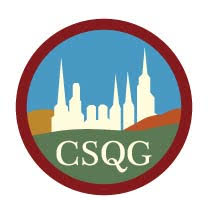There are a huge variety of ways to learn to quilt. Classes can often be found at local quilt or fabric shops or through other art and craft venues. There are a huge amount of books available at the library, as well as videos and classes on the internet. Guilds (whether ours or a different guild!) are also an invaluable resource, having not only speakers and workshops but the knowledge of experience of the guild's members.
Our Upcoming Community Classes
Our guild teaches workshops in partnership with the Delaplaine as a form of fundraising as a nonprofit organization. A list of some of our upcoming classes are below, but you can find more listings, detailed information, and registration at the Delaplaine at the following: https://delaplaine.org/instruction/
Sunday, June 30th, 12-4pm | Quilted Frederick Flag Tote Bag | The Delaplaine
Tuesdays, 7/9/24-7/30/24 (4 weeks), 6:00-9:00pm | Patchwork Pixels | The Delaplaine
Sunday, July 14th, 12:00-4:00pm | Embellished Twinchies with Denise Wagenaar | The Delaplaine
Saturday, August 24th, 1:00-4:00pm | Aesthetic Bows And Scrunchies (teens) | The Delaplaine
English Paper Piecing Resources
Hand sewing is very accessible and not expensive to start as you do not have to invest in a sewing machine. Read more below about English Paper Piecing, a classic technique that creates beautiful quilts in a very easy and affordable way. These resources will also give you all the information you need to get started if your purchased one of our kits.
Sewing Needles
Using quality, sharp needles is key to a nice stitch and easier sewing. Even nice needles are fairly inexpensive and worth the investment. If you have taken a class from us, you were supplied with a Roxanne's Appliqué Needle. These needles are generally available at quilt shops, and there are various other brands of appliqué needles. These needles are fine and long, making very small holes in the fabric and making it easy to achieve small and neat stitches. A basic wire needle threader is extremely helpful, as the needles use do have a very slender eye.
Thread
A finer thread than all purpose is helpful, for the same reasons you want a thinner needle. Our kits and classes use a 50wt cotton as it easy to handle and has to grip some it. However, as you learn you may want to switch to an even finer polyester or poly-blend (such a 60wt thread like Bottom Line) as it will glide more easily and be even more invisible. It is less prone to breakage and tangling, but as it has more slip you do need to be more aware of keeping your stitches snug.
Paper Templates
What kind of paper you use does matter for your templates -- you do want to use a cardstock as opposed to printer or copy paper so it has some stiffness and stability to it. You can print or trace templates onto cardstock at home and cut them out or purchase precut templates. Templates are removed from your work once piecing is complete.
Another option available is something called appliqué paper, which is what is use in our classes and kits. A one-side fusible partial water soluble paper. This paper has a heat activated glue on one side that you can iron onto your fabric, and once you have finished your quilt and washed it, the paper turns to a soft fabric. This way, it does not need to be removed. Appliqué paper is available as printable 8.5" x 11" sheets and as precut pieces. It is more expensive than cardstock and not as widely available. It is also not quite as stiff as cardstock, so can be slightly less stable to work with.
Washable Glue Stick
This can be your basic school glue stick or a special fabric glue stick, just make sure it washable. The purple glue stick is helpful as you can see it.
Fabric Scissors
You will want to have scissors that you reserve specifically for fabric, or you can use a rotary cutter and ruler. Separate thread scissors are great for snipping tiny threads and for portability for sewing on the go.
Optional Tools If you are using a flat back seam you will want to grab some blue painter's tape. Clover fabric clips are also helpful. You also may want to use a thimble if you find that sewing is making your finger sore.
Before you start sewing your quilt, you will need to baste your fabric to your templates. You can either glue baste or thread baste - read more about these techniques at Tales of Cloth.
In addition to different basting techniques, there are several different ways to sew EPP. The whipstitch is the traditional and most common way. Amira Saryati Ameruddin at The Little Mushroom Cap has a great round up of techniques on her website: you can read more here! Try them all and see what you like best.
